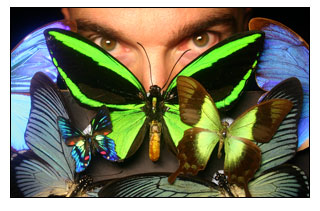EXETER, England, Nov. 22 -- The butterfly has been doing what physics couldn't for more than 30 million years, scientists at the University of Exeter have discovered.
Modern light-emitting devices have traditionally been inefficient, because most of the light created can't escape. Physicists have spent years analyzing LEDs (light-emitting diodes) ways to help to maximize the light released, including a mirror to reflect light and micro holes that stop light from being trapped inside the device or from spreading sideways.

The way light is extracted from a butterfly's system is more than an analogy, said University of Exeter researcher Pete Vukusic -- it's all but identical to LED design. (Photo: P.Vukusic, University of Exeter)
Butterflies, on the other hand, have evolved a unique mechanism to create a dazzling display of color that leaves physicists in the shade. It seems that anything we can do, nature can do better.
When physics professor Pete Vukusic studied African Swallowtail butterflies, he found they had evolved to include exactly these adaptations. They emit blue-green light for signalling using a fluorescent pigment on their wings.
Vukusic said, "It's amazing that butterflies have evolved such sophisticated design features that can so exquisitely manipulate light and color. Nature's design and engineering is truly inspirational. Pigment on the butterflies' wings absorbs ultraviolet light, which is then re-emitted, using fluorescence, as brilliant blue-green light. This adds to the color intensity of the wing."
Much of this light would be lost, resulting in a much duller effect, but the pigment is located in a region of the wing that has evenly spaced micro-holes through it, Vukusic added.
"The function of the micro-scales is identical to those in the LED; they prevent the fluorescent color from being trapped inside the structure and from being emitted sideways. The scales on the wing also have a specialized mirror underneath them, again very similar in design to the LED. This mirror upwardly reflects all the fluorescent ligh that gets emitted down toward it. The result is a very efficient system for fluorescent emission that gives the butterfly significant control of the direction in which the light is emitted."
The Exeter research is published in the journal Science.
For more information, visit: exeter.ac.uk